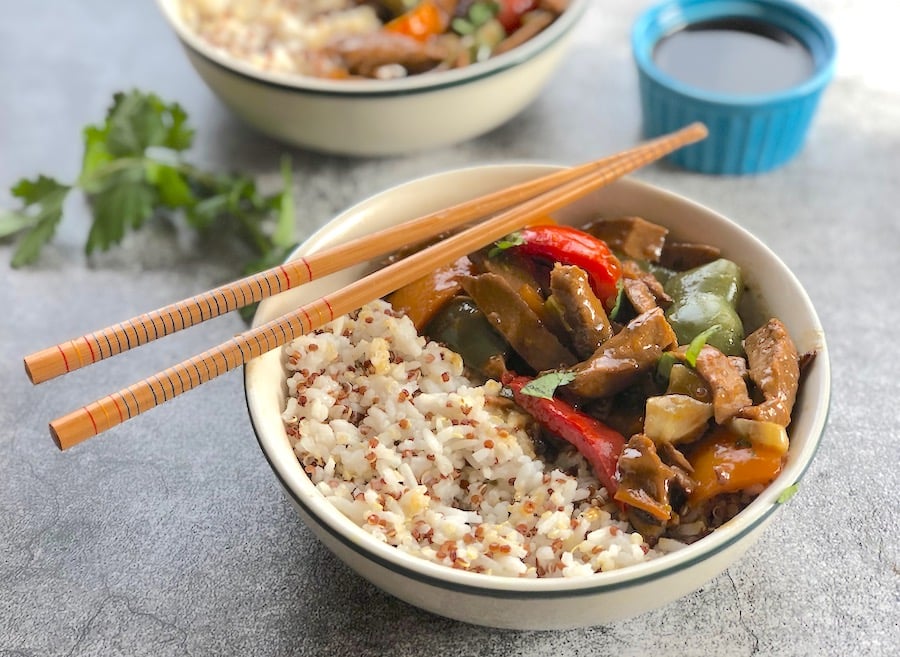Vegan Mongolian Beef is an easy recipe to prepare using plant-based beef-style protein or seitan. It’s a kinder, gentler way to enjoy an Asian-style dish. Though not traditional to the dish, this version adds asparagus and bell pepper, though you can use whatever vegetables you have on hand.

I was curious whether the dish known as Mongolian Beef has anything to do with Mongolia or its cuisine. It doesn’t. Like chop suey, it seems to be a Western invention.
What is it about that sweet-and-savory sauce that appeals so to the American palate? Could it be the full cup of sugar used in standard recipes to make the sauce? Yes, that’s a serious amount of sugar in a beefy dish.
This recipe eliminates the sugar, replacing it with apricot all-fruit preserves, which adds a subtly sweet flavor that enhances, rather than drowns, the flavors.
Delicious served with Easy Cold Noodles with Sesame Sauce as a side dish. Or, keep it simple and serve with rice or rice noodles.
Use seitan or plant-based beefy protein
Use up to a pound of packaged seitan, or, try this site’s Easy Homemade Seitan recipe. You’ll need about half of it for this recipe; freeze the rest for later use. See our Guide to Seitan featuring lots more hearty seitan recipes.
Or, use any brand of packaged beef-style or steak-style plant protein. Brands include:
- The Very Good Butchers
- Gardein
- Just Like Beef
- Viana
You can also try making this with Butler’s Soy Curls, though they won’t have quite as much of a “beefy” texture as the aforementioned.

Add some vegetables: The original version of Mongolian Beef is often served without any vegetable (other than scallions) – a wasted opportunity! I’ve opted to use asparagus, but feel free to use any other green vegetable or two, such as broccoli, bok choy, or green beans.
Photos by Hannah Kaminsky, BittersweetBlog.com.
Explore more …
Vegan Mongolian Beef with Asparagus & Peppers

Vegan Mongolian Beef is an easy dish to prepare using plant-based beef-style protein or seitan. It’s a kinder, gentler way to enjoy an Asian-style classic.
Ingredients
- 12 to 16 ounces beefy-style plant-based protein or seitan, cut into thin strips
- 2 tablespoons cornstarch or arrowroot
- 1/3 cup bottled or homemade teriyaki marinade (see link in Notes)
- 1/3 cup all-fruit apricot preserves
- 2 teaspoons minced fresh or bottled ginger
- 3 tablespoons neutral vegetable oil
- 3 to 4 cloves garlic, minced
- 10 to 12 stalks asparagus, bottoms trimmed and cut into 2-inch lengths
- 1/2 red or orange bell pepper, cut into short, thin strips
- 3 to 4 scallions, thinly sliced
- Hot cooked rice for serving
Instructions
- Combine the plant protein with cornstarch and stir to distribute.
- Combine the preserves, teriyaki sauce, and ginger in a small bowl and whisk together.
- Heat about half of the oil a skillet or stir-fry pan. When sizzling hot, add the plant beef strips and stir-fry over high heat for 8 minutes or so, until golden brown on most sides.
- Stir in half of the teriyaki mixture and continue to stir-fry for just a minute or so longer, until nicely glazed. Remove to a plate or bowl.
- Wipe our the pan, then heat the remaining oil in it. Add the garlic and sauté over low heat for a minute or so.
- Add the asparagus and a little water, just enough to keep the bottom of the pan moist. Turn the heat back up and stir-fry until bright green and tender-crisp, just a minute or two.
- Add the plant protein back in along with the bell pepper and about half of the scallion, leaving the rest for garnish. Pour in the restof the teriyaki mixture and continue to stir-fry briefly, just until everything is sizzling hot.
- Serve over or alongside hot cooked rice. Use the remaining scallion to garnish individual servings.
Notes
For the beefy-style plant protein, use packaged seitan or any of the brands mentioned above the recipe box; or Easy Homemade Seitan.

See lots more plant-based stir-fries and ways to veganize classic recipes.

Hello. I am a Mongolian lady. We don’t have like that food with many spices. Definitely it is chinese food. Please don’t get name Mongolian food.
Hi Erica — thanks for your comment. Like I said in the intro, I had a hunch that this is altogether an American invention with nothing “Mongolian” about it other than its name on Chinese restaurant menus!